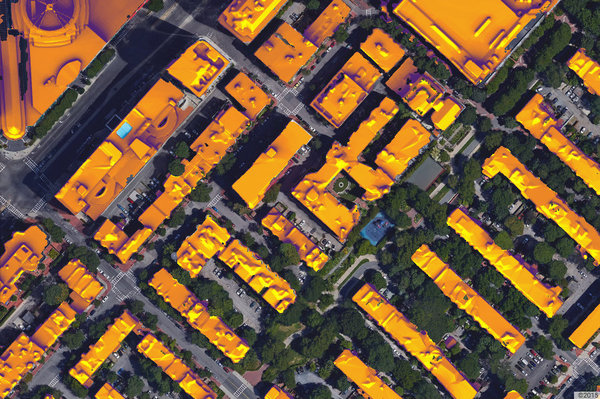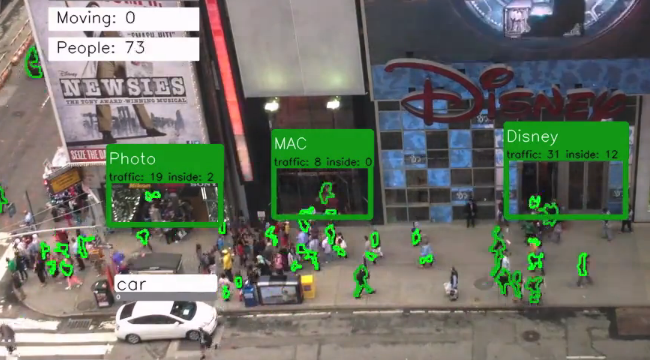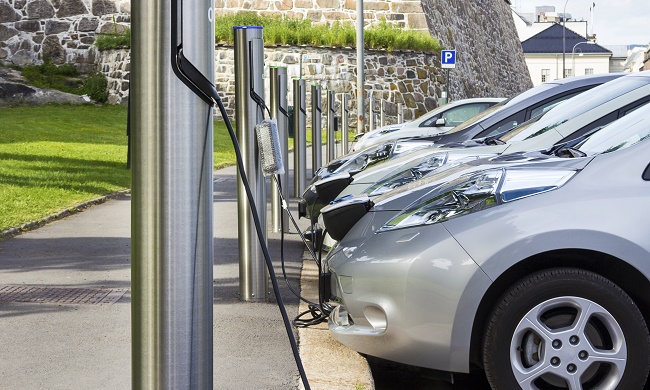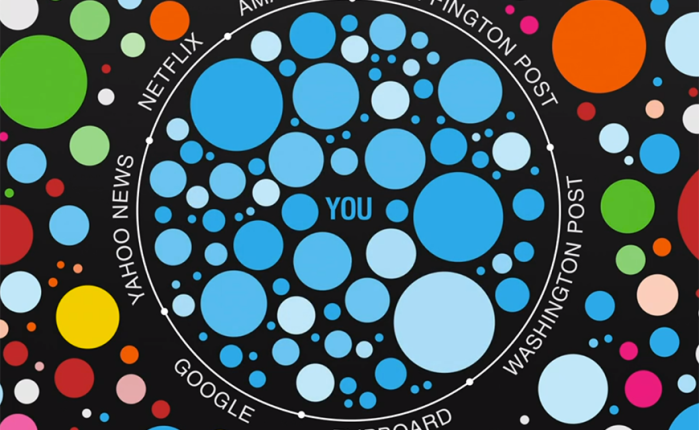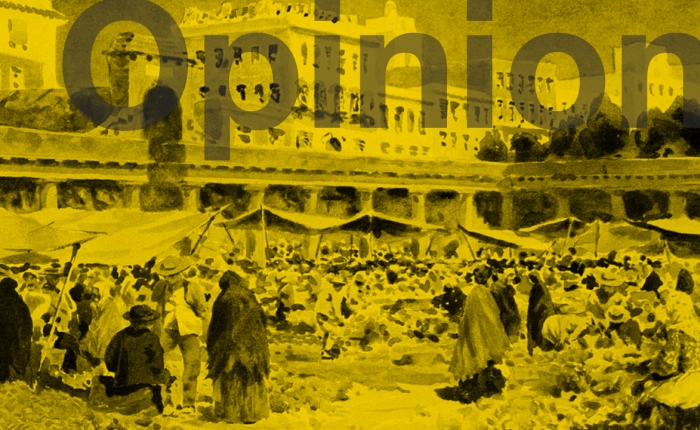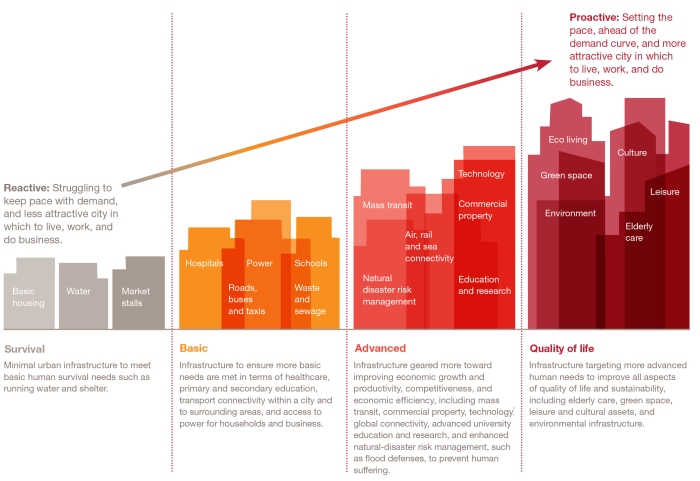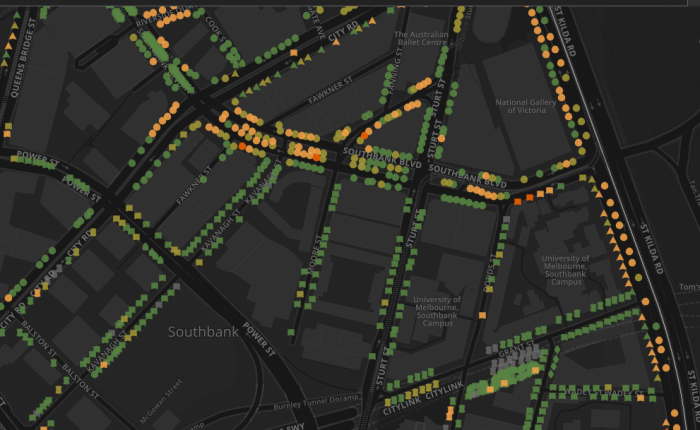The smart city comes with numerous benefits, from more adaptive mobility systems to enhanced service coordination, but when does a smart city turn dumb? In an insightful article, New Scientist looks at how technological advances have not been matched by similar security improvements. So far, cities have stayed one step ahead of hackers, but these vulnerabilities present a serious challenge to cities. They also present a valuable opportunity for integrated city-making firms.
Category: intelligence
Where Cities are Going, Next
In a recent post, I argued that the increasing complexity of developed cities necessitates coordination between different urban infrastructures to ensure operational efficiencies and produce social well-being. I also mentioned that new technologies – read: Big Data, Internet-of-Things, Smart City Systems – are not the centre of the ‘city of tomorrow,’ but merely its enablers. But where are cities going with this?
A good way to frame an answer to this question is not through the lens of new technologies, but through understanding where cities have been in the past, where they are now and, given this track record, where they are likely to be in the future: Hindsight and insight can lead to foresight.
To illustrate this process, I created the Evolution of Cities Roadmap that is depicted below. It includes the central ideas or ‘themes’ that have dominated post-industrial urban discourse since 1970 and potentially will do so for the next couple of decades. It shows, on a simplified timeline, how the basic components of cities – infrastructure, buildings, technology, and citizens – increasingly begin to overlap, interact, and build upon each other.
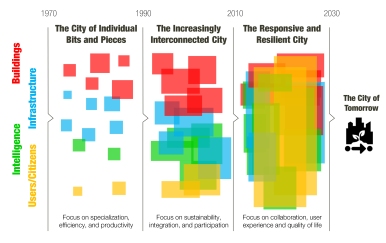 The first phase, called ‘The City of Bits and Pieces’ continues the tradition of specialization, a hallmark of the 20th century economy. It focuses on individual components (bridges, airports, hospitals, schools, traffic signals) and includes citizen participation primarily through elected representatives and public meetings. The emphasis is in providing products and services with as much efficiency as possible, usually through silo-ed institutions, meeting basic needs and improving productivity.
The first phase, called ‘The City of Bits and Pieces’ continues the tradition of specialization, a hallmark of the 20th century economy. It focuses on individual components (bridges, airports, hospitals, schools, traffic signals) and includes citizen participation primarily through elected representatives and public meetings. The emphasis is in providing products and services with as much efficiency as possible, usually through silo-ed institutions, meeting basic needs and improving productivity.
The second phase, ‘The Increasingly Interconnected City,’ roughly corresponding to the city of today, begins to recognize that its pieces are interconnected, part of a complex whole. It focuses on bridging the barriers between silos by harnessing the power of emerging technologies, such as workplace collaboration platforms and mobile-based end user apps. Public participation and input increasingly occurs through online outreach platforms and crowdsourced data that provides information for a more efficient and personalized provision of services.
The foundational changes in how the city is perceived in the first versus the second phase gives a powerful clue about how the third phase could look like. I’ve named it ‘The Responsive and Resilient City,’ because here the ties between end users and public and private service providers are bound to be further strengthened. The emphasis will shift from overly centralized organizations statistically predicting user needs in aggregate (think of public transit providers) to users themselves collaborating in real time to meet specific needs in a particular moment in time (think of mobile-phone-based car-sharing), increasing adaptability and resilience.
These changes go beyond cities. They are reflections on how the world is rapidly changing around us, based on a power shift towards the individual, enabled by the Internet age. What this user-centric, network-based new world means to cities is that they are compelled, by the expectations of its citizens, to become more responsive in real time to the needs of the individual, or, as John Hagel would put it, more “pull than push.” The New Urban Mechanics program, which started in Boston with an app to report graffiti and potholes, is a good example of this.
While still many issues, notably data privacy and security and the inequities of a rising digital divide, need to be solved, as many experts have pointed out, this evolving city notion has the potential to substantially alter the way people experience and interact with the physical city, with each other, and with service providers. Will it happen to the benefit of citizens? The jury is still out on this – but it certainly has the potential to do so.
By Oliver Hartleben, IBI TH!NK Coordinator
Locating Solar Panels, with Help from Google
Interest in renewable energy sources, including solar panels, has grown in recent years, but many people aren’t sure about what to do next. Recognizing how many people googled “solar panels” Google launched Project Sunroof to help home owners decide whether to install them. Currently established for Boston, San Francisco and Fresno, Project Sunroof informs owners how much sun they get and how much money they could save. Top-down information to encourage bottom-up solutions, steps towards a sustainable future.
Getting Smarter Traffic Counts
Traditionally involving people counting vehicles, bicycles and pedestrians, traffic counts have typically been time consuming and costly, with limited accuracy. However, new technology is reducing all three of these challenges. More detailed data enables smarter infrastructure investment and design, and besides, it’s important to measure what matters.
America’s Most Ambitious Electric Car Share Launched in…Indianapolis?
Indianapolis may not be the first city that comes to mind as a leader in car share systems, but last week, the city became just that. The BlueIndy system launched 25 charging stations and 50 cars, with plans scale up to 200 stations and 500 cars. But why Indianapolis? Home to many students and one the US’s worst public transit systems, BlueIndy sees strong market potential, with limited competition. An alternative to car ownership in similar cities? We look forward to the results.
The Filter Bubble Effect
The internet was heralded as a platform to cross boundaries and connect people with new and diverse ideas. Is it achieving this? In an illuminating TED Talk, pioneering online organizer Eli Pariser, author of The Filter Bubble, discusses how search engines, social media platforms and even news agencies are discretely tailoring content to the user. Considering that different users can get different results for the same Google Maps search, this could have dramatic real-life effects on diversity and the exchange of ideas in our cities.
The City of Today – Circle Back to the Past?
When I look at how cities have changed over the millennia, sometimes I get the impression that, in reality, they haven’t evolved much at all. For all of the physical differences between the insula and the detached home, the agora and shopping mall, the amphitheater and the Superdome, they all respond to key human activities in urban areas, or ‘live-work-play,’ as we like to say today.
Yet, on the other hand, there is no denying that cities around the world have undergone momentous change, especially in the last 300 years, starting with the first industrial revolution. The changes brought about by steam, electricity, and oil-based technologies enabled cities to become the engines of economic growth and – with a fair share of growing pains and social strains – a way to increase well-being and quality of life.
Some argue that a ‘third industrial revolution’ is in the works, one that is based on, on knowledge rather than manufacturing, on virtual connections rather than physical communication, and on sharing rather than owning. Just think of all the hype about “Smart Cities,” “Internet-of-Things,” and “Big Data” and how they will change the world we live in.
However, I am unsure whether these technology-centric approaches are well-suited to tell us how cities will be evolving, because, in the end, technology is only an enabler, a tool, for transformation; the real value is in understanding where this transformation is going, or rather, how it will change the way citizens perceive, use, and engage with the physical environment around them.
In a 2025 outlook on infrastructure spending, PricewaterhouseCoopers (PwC) determined that as cities evolve, more (and more elaborate and expensive) infrastructure is needed (see diagram below). Cities that are in survival mode require minimal infrastructure to meet basic human needs; and as they progress from basic to advanced and finally to what PwC calls ‘quality of life’ cities, their infrastructure becomes a catalyst for economic development and social well-being. Importantly, PwC’s visual diagram shows, intentionally or not, how the different infrastructures become increasingly overlapped, which is to me the key insight of the chart: as a city becomes more complex, the pieces within it interact (or will need to interact) more and more with each other.
In other words, the diagram portrays a city that functions most effectively when its elements are holistically integrated rather than in individual and highly specialized silos. This is not a new idea – it was already explored in the 1960s by Christopher Alexander in his article “A City is not a Tree,” which contended that cities have traditionally been highly complex entities that work on the basis of interrelated networks (think of mixed use traditional neighborhoods), rather than simple and clean hierarchical structures (think of single-use districts and Euclidean zoning).
The notion of a city understood as a whole was the norm in the preindustrial world: an intricate (others would say: messy) ecosystem, one not made necessary by complexity and technology, but rather imposed by proximity and human nature. Are we coming full circle now, when we envision the city of the future as an interconnected, holistic whole?
If this is in fact happening, it brings up interesting parallels with the so called “Gutenberg Parenthesis,” namely that the 400-year period between the invention of print and the advent of the internet is just an interlude in the 7,000-year old history of oral culture. The only difference between medieval and digital culture being that we’ve added technology, which is a facilitator and an amplifier of this oral culture at the global scale.
If we assume, for a moment, that the industrial revolution didn’t structurally transform the city but only caused a brief hiatus in how we interact with it, evolving technology (Big Data, Smart Cities, Internet-of-Things) could be the enablers – but not the guarantors – of an old-and-new citizen centered urban future. This is a future that, rather counterintuitively, could look more like ancient Rome than modernistic Brasilia.
By Oliver Hartleben, IBI TH!NK Coordinator
50 Ideas for More Creative and Playful Cities
Part talk series, community forum, brainstorming session, and party, Idea Bombing has been spreading across Australia. Based on two sessions in Melbourne, 50 ideas for creative and playful cities emerged. As one might expect from the description, the ideas are across the board, from the applied to the ridiculous, but in their sum, represent a collective effort to innovate how we interact with our neighbours and cities themselves.
Apps for Landscape Architects: Site Analysis and Design
To better understand how apps and smartphones are influencing their practice, the American Society of Landscape Architects conducted a global survey on app use for site analysis and design. 76% of respondents used an app for site analysis, 44% for conceptualization and design, and 47% used one for design reference. Want to find out what the most popular apps for each step of the design process were? Find out at The Dirt!
Mapping Melbourne’s Trees
Urban trees have been shown to provide considerable health and financial benefits, but can be difficult to keep alive and help thrive in grueling city environments. In an exciting engagement effort, the City of Melbourne created a digital map of the city’s 70,000+ trees, to educate its residents and encourage them to get involved. Big data can help everyone to create greener cities!


